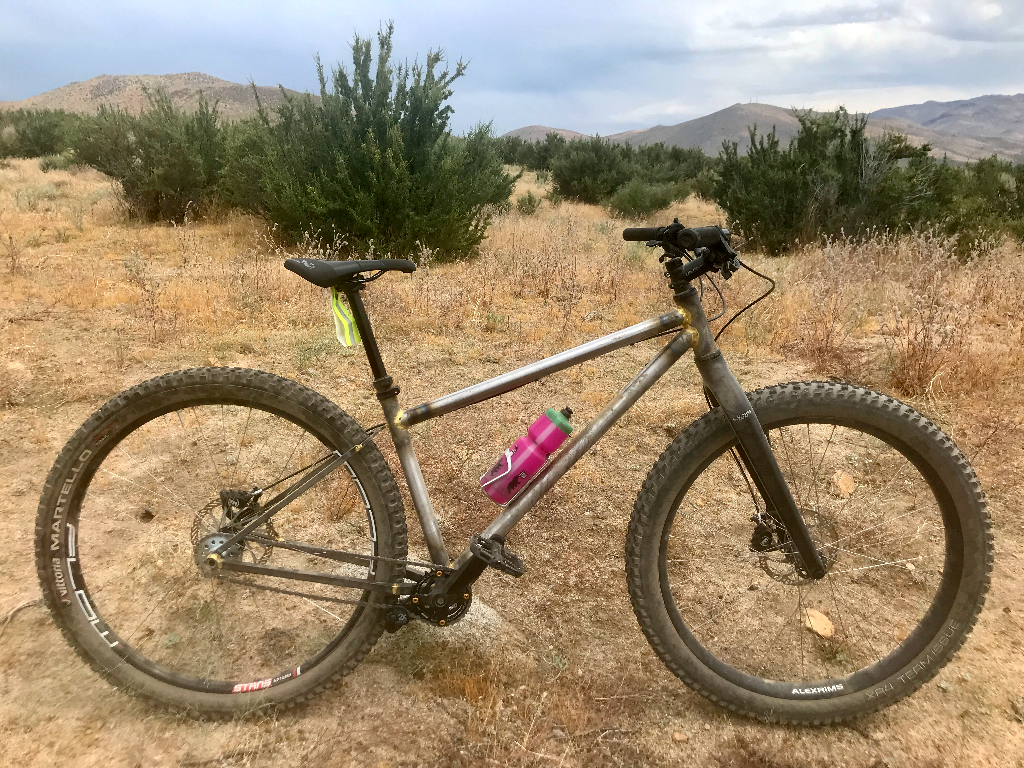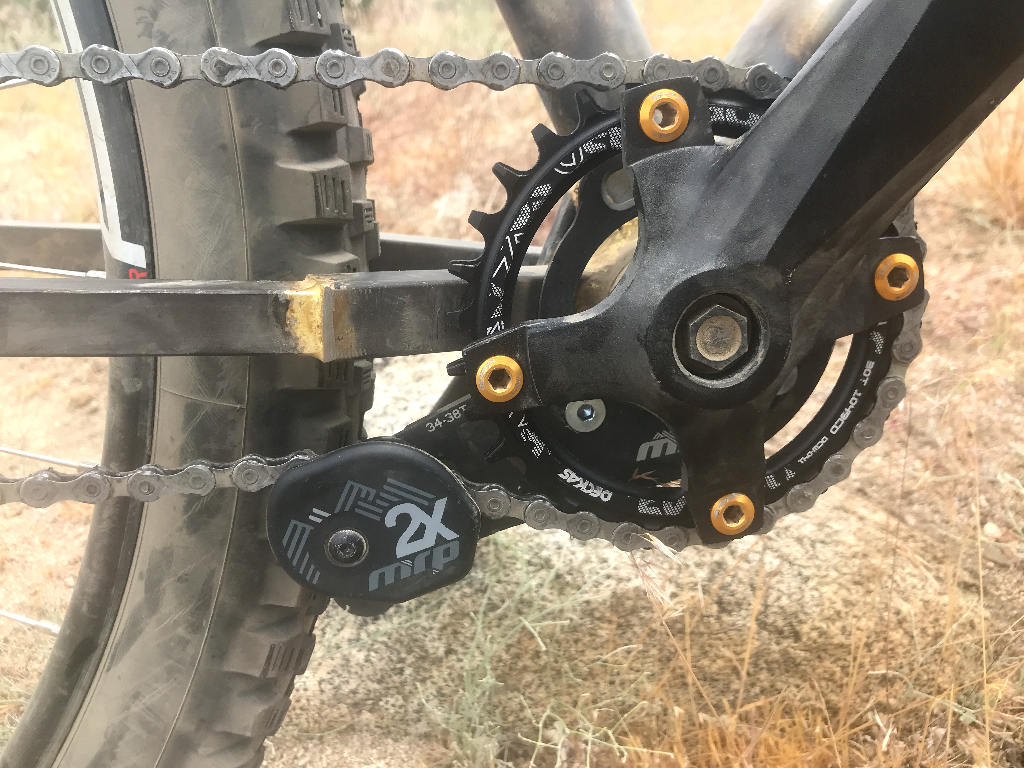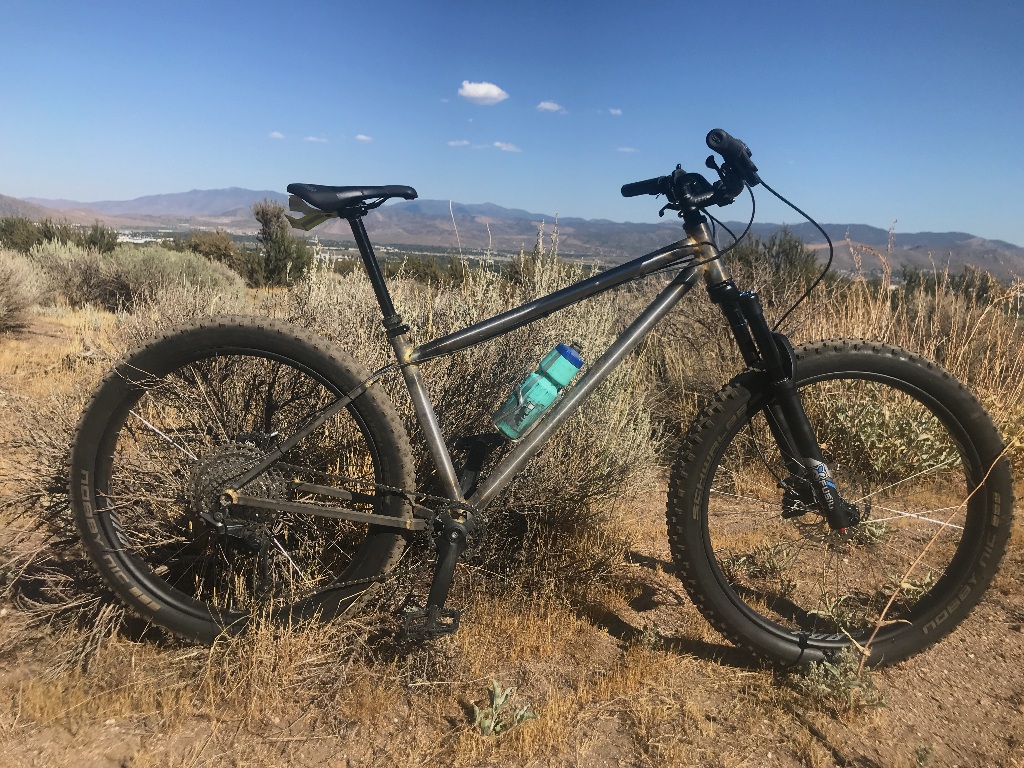Bike Check: SC-4
With SC-3 and the Ruby Roubaix behind me, it was time to build a new trail bike to take over from the fat bike's temporary role filling the need. I had really liked the first fat bike as a rigid 29+ trail bike, so I thought I'd use that as a basis but with short crank tweaks.

I had also been getting back into singlespeeds, so I was thinking about the best way to approach chain tensioning. I found inspiration in Andrew Major's experiments with ISCG guides for chain tensioning, so that seemed like an interesting detail to work with. Andrew's love for 29+ tires and longer stays also fit into the theme and geometry goals so this turned into an Andrew Major homage and I gave it the nickname "Meatwagon".
For geometry, I decided to go slacker. I kicked back the head angle and shortened the reach a little to keep the front center from getting too silly. A little extra stack was added for good measure. With builds lately I try to apply some randomness with the "chaos monkey" approach where I arbitrarily make one measurement more extreme. The idea here is that evolution is fueled by randomness at its core and it's sometimes more illuminating to not think you can deterministically design a bike around a bunch of numbers. So I slackened the head angle all the way to 64 degrees with a mullet rear wheel.
Continuing the short crank playbook, I moved the cranks forward in space and down a centimeter. Stays got a little more length too at the dropout end. The numbers are XXX chainstays with a XXX effective seat angle, but take out the short crank adjustment and it would be more like XX and XXX.
Fork was a generic carbon fatbike fork so I could use my old 29+ fatbike front wheel. I had a couple rear wheels I could use with everything from 30 to 50mm widths in both 27.5 and 29. Brakes: Magura XXX from the last trail bike. For cranks, though I designed the bike around 155s I used 165s for a little extra oomph pushing the single speed. I used another cheapo Fomtor/Ganopper crank since I have a bunch of 104 chainrings.
ISCG mounts were sold out everywhere or maybe people just stopped selling them, so I designed and laser-cut a batch with SendCutSend. For rear dropouts I was back to my favorite Paragon round snap-ring design. Chainstays were square like on SC-2, and I used the same yoke design I used on SC-3 but with square tubing and no monostay tube with the yoke brazed to the seat tube. Tubing was similar to the fat bike, the standard 38/35/35 combo I use for trail bikes. Shout out to BikeFabSupply for making an excellent 34.9 seat tube that saves me having to machine a collar. This build went well and everything went together straight and true.

I first built it up with the mullet rear wheel since it would give a lower singlespeed gear and give me a chance to try the bike at its slackest. I did have to offset the ISCG guide with some spacers since I'm running Superboost in the back with a 73mm bottom bracket shell. The guide I have is an older MRP 2X ring with dual tensioning pulleys so I was hoping to run the bike dinglespeed but by the time I settled on a gear ratio the novelty had worn off and I was good just running what I brung.

As for tensioning with an ISCG guide: you'll only get about a half-links worth of tensioning, so if you want to try something similar you need to pick a magic gear chainstay length and add 1-2 millimeters. You will be stuck with compatible magic ratios, so that means shifting two teeth front to back or adding/subtracting four teeth. In other words, if you design around 32-20, that means your other options are 30-22 and 34-18 with the same chain length. You can also run 32-24 by adding chain links. So design wisely.
The tensioner in practice works better than it should. It's quiet and doesn't seem to add any friction since it barely articulates the chain. I also think it looks kind of cool since it makes the top and bottom chain runs almost parallel. If you want a bike that can be sometimes singlespeeded but then can be run mostly geared without the faff of sliders or an eccentric BB this is a pretty good setup assuming you can pick a chainstay length that gives you the ratios you want.
First rides revealed one problem with two symptoms. First, with the smaller rear wheel and longer cranks I no longer had the pedal clearance I was used to, and single speed grinding doesn't always give you as much opportunity to finesse your cranks around rocks, so I was smacking my feet on everything. On top of that, the 64 head tube angle was too slack for a rigid fork and the bike would flop and oversteer in corners, even when slowed down with a Viscoset.
This was easily solved by switching to a 29" rear wheel. Well not exactly solved, but pedal strikes were reduced significantly. As for the handling, it was also improved a little but I still think the bike is too slack for a rigid fork. I might angleset it up another degree. Unfortunately evolution did it's thing and this random trait will not be passed on to future generations.
Fine tuning the handlebar location and playing around with my cornering technique didn't seem to make any progress with the handling. While I wasn't excited about its singletrack handling I enjoyed just rolling around my flatter gravel bike loops on the single speed, just cruising and not pushing any kind of pace. The slacker seat tube and better pedalling position is so comfortable it makes it easy to cruise and enjoy the scenery.
Just as I got it done and the build stabilized I caught COVID. With fall and winter coming, time was running out to ride the high country trails. So I decided to get anywhere in my weakened state I needed to put some gears on it. I also had a basic X-Fusion suspension fork to replace the rigid one. The fork has more offset plus it dives and gets shorter than the rigid fork, so when cornered hard it should flop into the apex less. Turns out the only Boost front wheels I had available were some carbon 27.5" B+ wheels so I put on some 27.5 x 3" Schwalbe Nobby Nics I was saving. I stole the 152 Fomtors off of the fat bike.

Testing so far it seems like the fork has helped the steering and it's less prone to diving into the apex of the corner as the rigid 29+ setup. With the fork doing it's thing it doesn't feel less stable either. I'm still getting the cockpit tuned plus I now have a fork to fiddle with but it seems like the handling is better in general. With gears that opens up more range to pedal it up towards the Tahoe Rim and more time descending. This bike hasn't really clicked for me yet so we'll see what I figure out and what I might need to adjust on the next one.